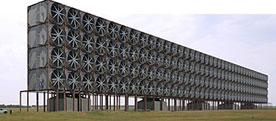As our planet hurtles toward climate scientists’ worst predictions about the level of temperature rise they expect, the calls are getting louder for geo-engineering.
Although this area of research has received little funding, scientists say it’s time to get prepared – and at least have a tool kit available – as a last resort, which the world may unfortunately need.
Many of the ideas relate to "humans’ attempt to control or manipulate the environment" on a global scale by seeding clouds (mimicking volcanoes), putting great mirrors in space to reflect sunlight away from earth or fertilizing the oceans, all of which could have devastating unintended consequences.
But air capture technology simply removes carbon from the air after which it can be re-used in industrial processes or sequestered underground.
In the UK, the Institution of Mechanical Engineers say they will have carbon capture technology ready by 2018. Their device, which resembles a giant fly swatter, absorbs carbon 1000 times more efficiently from the air than a similarly sized tree.
They say: "Many people believe that we are fast approaching a critical point in dealing with climate change. The consensus is that we cannot allow global average temperature to rise by 2 degreesC above pre-industrial levels. If we do – and many predict this will happen within the next few decades – dramatic changes to our climate may occur which could jeopardise modern civilisation. Geo-engineering is not a ‘silver bullet’, but it could be a component that provides the world with extra time to decarbonise the global economy."
The 3 solutions they find most promising are:
Artificial trees
Designed to mimic a tree, a machine removes carbon from the atmosphere when air passes through the device. CO2 simply sticks to a sorbent material, which behave like leaves. That’s what Carbon Engineering is developing, who we refer to below.

Hong-Cai Zhou, a chemistry professor at Texas A&M University is also developing a carbon "fly trap."
His work is based on a new class of materials, "metal organic frameworks," which have the highest surface area of any known substance. A sugar cube-size piece can provide a football-field of surface area; CO2 sticks to its crystalline lattice. A plant operator would simply run waste gases through a small tank with "greenhouse gas glue." Framergy licenses the technology for commercial development. The tank can be washed and re-used to produce algae biofuels or sequestered in the ground in saline formations. It could be on the market in 3-5 years.
Algae-coated buildings
Algae naturally absorbs CO2 through photosynthesis. Strips of algae can be fitted to the outside of buildings and then periodically harvested for use as biofuels in conjunction with a carbon sequestration solution.
3. Reflective buildings
Surfaces would be made more reflective to reduce the amount of solar radiation absorbed by the earth, which could cool the planet. This less effective option could be used in tandem and reduce urban heat islands as well.
Wealthy Individuals Jumping In
Besides the concerns about unintended consequences of geo-engineering, people are worried that some of these technologies could get into the wrong hands, from terrorists to corporations.
Bill Gates, Sir Richard Branson, tar sands magnate Murray Edwards and Niklas Zennström, co-founder of Skype, and and other wealthy individuals have financed official reports on the future use of geoengineering, raising concerns that wealthy people could have undue influence on policy.
Gates donated $4.6 million for the Fund for Innovative Climate and Energy Research at Harvard University, run by two professors that are leading advocates of geoengineering research, report the Guardian.
The group has produced reports such as UK Royal Society report on Solar Radiation Management, and the US Taskforce on Geoengineering.
Gates and Edwards have equity stakes in a company, Carbon Engineering, which is developing air capture technology – one of the Harvard professors is President.
In sum, private individuals are bankrolling this research. Some find it reassuring that people who have the money are supporting this work, which could be the world’s only hope. Others worry about conflicts of interest and less-than-morale motivations.
We wrote this article back in 2007, but it holds true today: The Promise of Air Capture.
Here’s a blog on Geoengineering.
Read the full story at the Guardian:

I read this on a Sandia National Labs site last year. Concentrating solar to fuel..
http://www.technologyreview.com/energy/23996/
CO2 makes some sense, though a mighty big job on the global scale. Ironically it will “create Jobs.”
Solar Radiation Management on the other hand is risky and uncertain. Reflective building paints for instance may actually disrupt existing clouds.
However, since growth and economy are very unlikely to cease relentless forward motion, some of these measures are likely to be adopted.
In the meantime, enjoy the outdoors we still have. Walk, ride a bike, eBike, take transit or drive an EV.
EVsRock!
http://www.evsroll.com